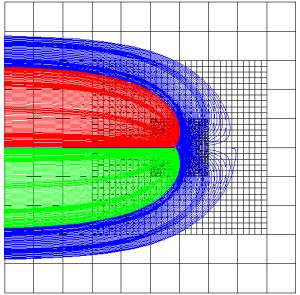Modelling groundwater systems

Climate change and changing human pressures on our environment require us to make predictions about the future sustainability of our water resources. This necessitates the use of models.
Our modelling research focuses on the development and application of models to improve our understanding of hydrological and groundwater processes and to allow predictions about the future to be made.
Groundwater modelling research
We undertake modelling research in collaboration with universities and other research institutes, industry, environmental regulators and, government and non-government organisations that addresses a wide range of environmental issues including:
- effects of climate change on groundwater resources
- changes in groundwater flood and drought occurrence
- impact of CO2 injection and underground storage on water resources
- effect of agricultural pollution on water quality
- movement of contaminants through groundwater systems
- development of new public groundwater supplies
- quantification of national water resources
- effectiveness of flood alleviation schemes
- impacts of groundwater abstraction on rivers
- effectiveness of ground source heating and cooling schemes
Modelling services
In addition to our research activities we undertake modelling projects for a number of commercial clients. Our groundwater modelling specialists are skilled in both applying existing modelling tools and developing bespoke software in order to provide robust answers to our clients' questions.
Modelling software
BGS has developed a number of groundwater modelling software tools that simulate groundwater systems at a range of scales.
The ZOOM suite of models has been designed to simulate local scale flows within regional and national scale groundwater systems. The suite consists of the distributed groundwater recharge model, ZOODRM, the saturated groundwater flow model ZOOMQ3D and the advective solute transport code, ZOOPT. These codes have been applied to a wide range of hydrogeological conditions and hydrological regimes from the arid West Bank, Palestine, to the Dumfries Basin sandstone aquifer in Scotland.
To answer science questions related to environmental change our research is becoming more interdisciplinary. This is requiring the integration of models of different compartments of the water cycle. To facilitate this we are implementing software tools to that enable different models to interact with each other. New technologies such as OpenMI are being used link our models to those of other environmental software developers. For example: we have linked an InfoWorksRS river model with a ZOOMQ3D groundwater model while working in partnership with HR Wallingford. This is being used to simulate the processes operating during the fluvial-driven groundwater floods in Oxford during July 2007.
Contact
Contact Dr Christopher Jackson for further information.
- BGS groundwater modelling publications
- Simple automatic time-stepping for improved simulation of groundwater hydrographs
- How to get your model results used : a guide to stakeholder engagement
- Grid refinement in Cartesian Coordinates for groundwater flow models using the Divergence Theorem and Taylor’s Series
- Numerical testing of conceptual models of groundwater flow: a case study using the Dumfries Basin aquifer






